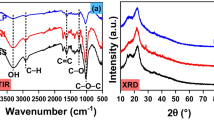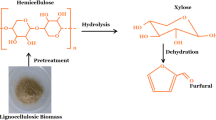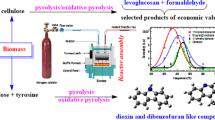Abstract
Recently, pyrolysis has raised great interest due to its high potential for yield high-quality bio-oil and value-added chemical production with the ability to be used as renewable energy, and/or for the production of high value-added chemical compounds. The chemical compounds produced and their quantities are entirely related to the characteristics and chemical composition of the precursor biomass and fast pyrolysis process conditions. In this work, Dendrocalamus asper biomass was performed using fast pyrolysis coupled to gas chromatography with mass spectrometry detector (Py-GC-MS). The non-wood biomass was characterized according to its chemical composition by determination and elemental composition. The biomass chemical composition have shown cellulose content (46.4%), hemicellulose content (14.9%), and Klason lignin content (18.9%). In addition, elemental composition demonstrated percentages of carbon (48.4%), oxygen (42.4%), and hydrogen (6.1%). In relation to carbohydrates, Py-GC-MS analyses showed the formation of several compounds of interest, such as acetic acid and, in smaller amounts, syringol, isoeugenol, and levoglucosan. On the other hand, the major compound found was 2,3-dihydrobenzofuran (~128 kg/ton), which is a high value-added chemical compound for pharmacy industry. Several studies have demonstrated the potential of this 2,3-dihydrobenzofurans for pharmacological use, such as anti-tumor, anti-cancer, anti-tubercular, anti-malarial, anti-bacterial, anti-oxidant, and anti-viral activities. The techno-economic assessment showed that 2,3-dihydrobenzofuran has a high market price (6977.68 US$/ton), and that a single-batch production will lead to a positive techno-economic balance, with high-potential profitable business. Finally, the present study offers an effective and eco-friendly method for processing agroindustrial waste, which enables the 2,3-dihydrobenzofurans with high yield and quality.
Graphical Abstract








Similar content being viewed by others
Data availability
The datasets used can be accessed as requested by the authors.
References
Mastini R, Kallis G, Hickel J (2021) A green new deal without growth? Ecol Econ 179:106832. https://doi.org/10.1016/j.ecolecon.2020.106832
Halkos G, Gkampoura EC (2021) Where do we stand on the 17 Sustainable Development Goals? An overview on progress. Econ Anal Policy 70:94–122. https://doi.org/10.1016/j.eap.2021.02.001
Ashokkumar V, Chen WH, Kumar G et al (2021) A biorefinery approach for high value-added bioproduct (astaxanthin) from alga Haematococcus sp. and residue pyrolysis for biochar synthesis and metallic iron production from hematite (Fe2O3). Fuel 304:121150. https://doi.org/10.1016/j.fuel.2021.121150
Tran QK, Le ML, Ly HV et al (2021) Fast pyrolysis of pitch pine biomass in a bubbling fluidized-bed reactor for bio-oil production. J Ind Eng Chem 98:168–179. https://doi.org/10.1016/j.jiec.2021.04.005
Fiore S, Berruti F, Briens C (2018) Investigation of innovative and conventional pyrolysis of ligneous and herbaceous biomasses for biochar production. Biomass Bioenergy 119:381–391. https://doi.org/10.1016/j.biombioe.2018.10.010
Chen W, Chen Y, Yang H et al (2017) Co-pyrolysis of lignocellulosic biomass and microalgae: products characteristics and interaction effect. Bioresour Technol 245:860–868. https://doi.org/10.1016/j.biortech.2017.09.022
Pego MFF, Bianchi ML, Veiga TRLA (2019) Avaliação das propriedades do bagaço de cana e bambu para produção de celulose e papel. Rev Ciências Agrárias 1–11. 10.22491/rca.2019.3158
Kumar D, Mandal A (2022) Review on manufacturing and fundamental aspects of laminated bamboo products for structural applications. Constr Build Mater 348:128691. https://doi.org/10.1016/j.conbuildmat.2022.128691
Wang Y, Li Y, Li C et al (2022) Catalytic pyrolysis of bamboo residue and its extracted three main components over copper modified ZSM-5 for the production of aromatic hydrocarbons. J Anal Appl Pyrolysis 167:105692. https://doi.org/10.1016/j.jaap.2022.105692
Zheng C, Zhang H, Xu L, Xu F (2022) Production of multifunctional bamboo-based phase change encapsulating material by straightforward dry ball milling. J Energy Storage 46:103630. https://doi.org/10.1016/j.est.2021.103630
Sun H, Li H, Dauletbek A et al (2022) Review on materials and structures inspired by bamboo. Constr Build Mater 325:126656. https://doi.org/10.1016/j.conbuildmat.2022.126656
Mendiara T, García-Labiano F, Abad A et al (2018) Negative CO2 emissions through the use of biofuels in chemical looping technology: a review. Appl Energy 232:657–684. https://doi.org/10.1016/j.apenergy.2018.09.201
Sun Y, Li C, Li Q et al (2021) Pyrolysis of flaxseed residue: exploration of characteristics of the biochar and bio-oil products. J Energy Inst 97:1–12. https://doi.org/10.1016/j.joei.2021.03.020
Getahun A, Kebede Y, Tadese Z et al (2023) Growth and biomass production of five exotic bamboo species in North-western Ethiopia. Adv Bamboo Sci 4:100030. https://doi.org/10.1016/j.bamboo.2023.100030
Felisberto MHF, Beraldo AL, Sentone DT et al (2021) Young culm of Dendrocalamus asper, Bambusa tuldoides and B. vulgaris as source of hemicellulosic dietary fibers for the food industry. Food Res Int 140. https://doi.org/10.1016/j.foodres.2020.109866
De Souza Santos DR, Sette CR, Da Silva MF et al (2016) Potencial de espécies de Bambu como fonte energética. Sci For 44:751–758. https://doi.org/10.18671/scifor.v44n111.21
Proksch P, Rodriguez E (1983) Chromenes and benzofurans of the asteraceae, their chemistry and biological significance. Phytochemistry 22:2335–2348. https://doi.org/10.1016/0031-9422(83)80118-6
Dapkekar AB, Sreenivasulu C, Ravi Kishore D, Satyanarayana G (2022) Recent advances towards the synthesis of dihydrobenzofurans and dihydroisobenzofurans. Asian J Org Chem 11. https://doi.org/10.1002/ajoc.202200012
Chen Y, Ning Y, Chen Z et al (2023) Design, synthesis and pharmacological evaluation of 2,3-dihydrobenzofuran IRAK4 inhibitors for the treatment of diffuse large B-cell lymphoma. Eur J Med Chem 256:115453. https://doi.org/10.1016/j.ejmech.2023.115453
Miao YH, Hu YH, Yang J et al (2019) Natural source, bioactivity and synthesis of benzofuran derivatives. RSC Adv 9:27510–27540. https://doi.org/10.1039/c9ra04917g
Gouhar RS, Ewies EF, El-Shehry MF et al (2018) Synthesis and utility of α,β-unsaturated ketone bearing naphthalene and benzofuran rings in the synthesis of some N-heterocycles with their antiviral and antitumor activity evaluation. J Heterocyclic Chem 55:2368–2380. https://doi.org/10.1002/jhet.3301
Chowdhury SR, Gu J, Hu Y et al (2021) Synthesis, biological evaluation and molecular modeling of benzofuran piperidine derivatives as Aβ antiaggregant. Eur J Med Chem 222:113541. https://doi.org/10.1016/j.ejmech.2021.113541
Thies W, Bleiler L (2012) 2012 Alzheimer’s disease facts and figures. Alzheimers Dement 8:131–168. https://doi.org/10.1016/j.jalz.2012.02.001
Pandey A, Soccol CR, Nigam P, Soccol VT (2000) Biotechnological potential of agro-industrial residues. I: Sugarcane bagasse. Bioresour Technol 74:69–80. https://doi.org/10.1016/S0960-8524(99)00142-X
Lu Y, Gu K, Shen Z et al (2023) Biochar implications for the engineering properties of soils: a review. Sci Total Environ 888. https://doi.org/10.1016/j.scitotenv.2023.164185
Guimarães T, De Oliveira AF, Lopes RP, De Carvalho Teixeira AP (2020) Biochars obtained from arabica coffee husks by a pyrolysis process: characterization and application in Fe(ii) removal in aqueous systems. New J Chem 44:3310–3322. https://doi.org/10.1039/c9nj04144c
Nachenius RW, Ronsse F, Venderbosch RH, Prins W (2013) Biomass pyrolysis. Adv Chem Eng 42:75–139. https://doi.org/10.1016/B978-0-12-386505-2.00002-X
Pontes NS, Silva RVS, Ximenes VL et al (2021) Chemical speciation of petroleum and bio-oil coprocessing products: Investigating the introduction of renewable molecules in refining processes. Fuel 288. https://doi.org/10.1016/j.fuel.2020.119654
Plouffe C, Peterson CA, Rollag SA, Brown RC (2022) The role of biochar in the degradation of sugars during fast pyrolysis of biomass. J Anal Appl Pyrolysis 161:105416. https://doi.org/10.1016/j.jaap.2021.105416
Kumar A, Biswas B, Saini K et al (2021) Py-GC/MS study of prot lignin with cobalt impregnated titania, ceria and zirconia catalysts. Renew Energy 172:121–129. https://doi.org/10.1016/j.renene.2021.03.011
Li X, Liu Q, Si C et al (2018) Green and efficient production of furfural from corn cob over H-ZSM-5 using γ-valerolactone as solvent. Ind Crop Prod 120:343–350. https://doi.org/10.1016/j.indcrop.2018.04.065
Guo Q, Zhang Z, Zhao L et al (2023) Release and evolution mechanism of oxygen-containing compounds and aromatics during the co-pyrolysis of waste tire and bamboo sawdust/rice husk by Py-GC/MS. J Anal Appl Pyrolysis 170:105923. https://doi.org/10.1016/j.jaap.2023.105923
Bañón E, García AN, Marcilla A (2021) Thermogravimetric analysis and Py-GC/MS for discrimination of leather from different animal species and tanning processes. J Anal Appl Pyrolysis 159. https://doi.org/10.1016/j.jaap.2021.105244
Poulin J, Kearney M, Veall M-A (2022) Direct inlet Py-GC-MS analysis of cultural heritage materials. J Anal Appl Pyrolysis 164:105506. https://doi.org/10.1016/j.jaap.2022.105506
Ghysels S, Rathnayake D, Maziarka P et al (2022) Biochar stability scores from analytical pyrolysis (Py-GC-MS). J Anal Appl Pyrolysis 161. https://doi.org/10.1016/j.jaap.2021.105412
Hidayat S, Abu Bakar MS, Yang Y et al (2018) Characterisation and Py-GC/MS analysis of Imperata cylindrica as potential biomass for bio-oil production in Brunei Darussalam. J Anal Appl Pyrolysis 134:510–519. https://doi.org/10.1016/j.jaap.2018.07.018
Liang F, Wang R, Hongzhong X et al (2018) Investigating pyrolysis characteristics of moso bamboo through TG-FTIR and Py-GC/MS. Bioresour Technol 256:53–60. https://doi.org/10.1016/j.biortech.2018.01.140
Segal L, Creely JJ, Martin AE, Conrad CM (1959) An empirical method for estimating the degree of crystallinity of native cellulose using the X-ray diffractometer. Text Res J 29:786–794. https://doi.org/10.1177/004051755902901003
Demuner IF, Gomes FJB, Coura MR et al (2021) Determination of chemical modification of eucalypt kraft lignin after thermal treatment by Py-GC–MS. J Anal Appl Pyrolysis 156. https://doi.org/10.1016/j.jaap.2021.105158
Oudia A, Mészáros E, Simões R et al (2007) Pyrolysis-GC/MS and TG/MS study of mediated laccase biodelignification of Eucalyptus globulus kraft pulp. J Anal Appl Pyrolysis 78:233–242. https://doi.org/10.1016/j.jaap.2006.07.003
Xu S, Chen J, Peng H et al (2021) Effect of biomass type and pyrolysis temperature on nitrogen in biochar, and the comparison with hydrochar. Fuel 291:120128. https://doi.org/10.1016/j.fuel.2021.120128
Liu Z, Fei B, Jiang Z, Liu X (2014) Combustion characteristics of bamboo-biochars. Bioresour Technol 167:94–99. https://doi.org/10.1016/j.biortech.2014.05.023
Peng Y, Tang X, Xuan R et al (2021) Analysis of pyrolysis behaviors of biomass extractives via non-linear stepwise heating program based on Gaussian multi-peak fitting of differential thermogravimetric curve. https://doi.org/10.1016/j.tca.2021.178976
Scurlock JMO, Dayton DC, Hames B (2000) Bamboo: an overlooked biomass resource? Biomass Bioenergy 19:229–244. https://doi.org/10.1016/S0961-9534(00)00038-6
Mi B, Liu Z, Hu W et al (2016) Investigating pyrolysis and combustion characteristics of torrefied bamboo, torrefied wood and their blends. Bioresour Technol 209:50–55. https://doi.org/10.1016/j.biortech.2016.02.087
Yang TC, Yang YH, Yeh CH (2021) Thermal decomposition behavior of thin Makino bamboo (Phyllostachys makinoi) slivers under nitrogen atmosphere. Mater Today Commun 26:102054. https://doi.org/10.1016/j.mtcomm.2021.102054
Biswas S, Rahaman T, Gupta P et al (2022) Cellulose and lignin profiling in seven, economically important bamboo species of India by anatomical, biochemical, FTIR spectroscopy and thermogravimetric analysis. Biomass Bioenergy 158:106362. https://doi.org/10.1016/j.biombioe.2022.106362
Jianfei Y, Zixing F, Liangmeng N et al (2020) Combustion characteristics of bamboo lignin from kraft pulping: influence of washing process. Renew Energy 162:525–534. https://doi.org/10.1016/j.renene.2020.08.076
Liu L, Pang Y, Lv D et al (2021) Thermal and kinetic analyzing of pyrolysis and combustion of self-heating biomass particles. Process Saf Environ Prot 151:39–50. https://doi.org/10.1016/j.psep.2021.05.011
Kumar D, Mandal A (2023) Response surface method-based optimisation of advanced mechanochemical approach for bead minimisation in bamboo fiber extraction, and improving hydrophobicity via diisopropanolamine treatment. Biomass Convers Biorefin. https://doi.org/10.1007/s13399-023-04420-5
Service USDAF (1970) Thermal degradation of wood components : a review of the literature FPL 130
Cheng K, Winter WT, Stipanovic AJ (2012) A modulated-TGA approach to the kinetics of lignocellulosic biomass pyrolysis/combustion. Polym Degrad Stab 97:1606–1615. https://doi.org/10.1016/j.polymdegradstab.2012.06.027
Shyam S, Arun J, Gopinath KP et al (2022) Biomass as source for hydrochar and biochar production to recover phosphates from wastewater: a review on challenges, commercialization, and future perspectives. Chemosphere 286:131490. https://doi.org/10.1016/j.chemosphere.2021.131490
Lou R, Bin WS, Lv GJ (2010) Effect of conditions on fast pyrolysis of bamboo lignin. J Anal Appl Pyrolysis 89:191–196. https://doi.org/10.1016/j.jaap.2010.08.007
Romão D, Santana C Jr, Brito M et al (2022) Assessment of the economic and energetic potential of residues from the green coconut industry. J Braz Chem Soc 00:1–10. https://doi.org/10.21577/0103-5053.20220042
Ji Y, Zhang C, Zhang XJ et al (2022) A high adsorption capacity bamboo biochar for CO2 capture for low temperature heat utilization. Sep Purif Technol 293:121131. https://doi.org/10.1016/j.seppur.2022.121131
Mazar A, Ajao O, Benali M et al (2020) Integrated multiproduct biorefinery for furfural production with acetic acid and lignin recovery: design, scale-up evaluation, and technoeconomic analysis. ACS Sustain Chem Eng 8:17345–17358. https://doi.org/10.1021/acssuschemeng.0c04871
Funding
The authors are thankful for the financial support provided by Fundação de Amparo à Pesquisa do Estado de Minas Gerais – Brazil (FAPEMIG), Conselho Nacional de Desenvolvimento Científico e Tecnológico – Brazil (CNPq/FAPEMIG agreement recorded in SICONV: 793988/2013 and INCT Midas) and Coordenação de Aperfeiçoamento de Pessoal de Nível Superior – Brasil (CAPES – Finance Code 001). SAF is supported by research fellowships from CNPq. To the Laboratory of Nanomaterials and Environmental Chemistry (LANAQUA-UFV) and Laboratory Pulp and Paper (LCP-UFV).
Author information
Authors and Affiliations
Contributions
Marcelo Moreira da Costa: conceptualization, methodology, resources, funding acquisition, investigation, formal analysis, writing — review and editing, supervision; Tiago Guimarães: conceptualization, methodology, investigation, formal analysis, writing — original draft, writing — review and editing; Kamila Demarques França: conceptualization, methodology, investigation, formal analysis, writing — original draft, writing — review and editing; Larissa Soares Silva: conceptualization, methodology, investigation, formal analysis, writing — original draft, writing — review and editing; Rodrigo Fraga de Almeida: conceptualization, methodology, investigation, formal analysis; Thainá Costa Henrique: methodology, investigation, formal analysis; Sergio Antonio Fernandes: conceptualization, writing — review and editing, supervision; Grazieli Viana Tuler: conceptualization, methodology, investigation, formal analysis, writing — original draft, writing — review and editing; Ricardo Carvalho Bittencourt: conceptualization, methodology, investigation, formal analysis, writing — original draft, writing — review and editing; Verônica Oliveira de Paula Barbosa: conceptualization, methodology, investigation, formal analysis, writing — original draft, writing — review and editing; Ana Márcia Macedo Ladeira Carvalho: conceptualization, methodology, resources, funding acquisition, investigation, formal analysis, writing — review and editing, supervision.
Corresponding author
Ethics declarations
Ethical approval
Not applicable.
Competing interests
The authors declare no competing interests.
Additional information
Publisher’s Note
Springer Nature remains neutral with regard to jurisdictional claims in published maps and institutional affiliations.
Supplementary information
ESM 1
(DOCX 496 kb)
Rights and permissions
Springer Nature or its licensor (e.g. a society or other partner) holds exclusive rights to this article under a publishing agreement with the author(s) or other rightsholder(s); author self-archiving of the accepted manuscript version of this article is solely governed by the terms of such publishing agreement and applicable law.
About this article
Cite this article
da Costa, M.M., Guimarães, T., França, K.D. et al. 2,3-Dihydrobenzofuran production eco-friendly by fast pyrolysis from Dendrocalamus asper biomass. Biomass Conv. Bioref. (2023). https://doi.org/10.1007/s13399-023-05075-y
Received:
Revised:
Accepted:
Published:
DOI: https://doi.org/10.1007/s13399-023-05075-y




